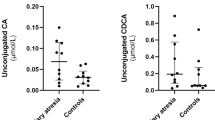Abstract
Objective
The chemical composition and clinical significance of white bile in patients with malignant obstructive jaundice were evaluated in a prospective study.
Materials and methods
115 consecutive patients with inoperable malignant biliary obstruction underwent endoscopic placement of 10 Fr straight, plastic biliary stents, Amsterdam-type. Bile was aspirated during the endoscopic procedure and a blood sample was taken. Patients were divided into two groups: those with white bile and those with yellow bile. The groups were compared for decremental fall in bilirubin, cholangitis after stent insertion, and survival.
Results
Thirty-five patients (15 men, 20 women; mean age 54 years) underwent endoscopic drainage for malignant obstruction (29 hilar, 6 distal bile duct). Eighteen patients had white bile. Refractory jaundice (p > −0.025) was seen in nine (50%) patients with white bile compared with three (17.6%) patients with yellow bile; mean difference −42.2 (95% CI [−62.4, −22.0]) and −45.7 (95% CI [−72.0, −19.4]), respectively. The bilirubin (0.49 mg/L) and bile acid (14.6 mmol/L) concentrations in white bile were significantly less than bilirubin (41.9 mg/L) and bile acid (62.2 mmol/L) concentrations in yellow/black bile. Cholangitis developed in 66.6% of patients with white bile compared with 35% of those with yellow/black bile (OR 3.67: 95% CI [0.74, 19.25]). Kaplan–Meier curves showed that median survival was shorter in patients with white bile (36 [23–60] vs 75 [35–220] days) (p = 0.004, log rank test), which was significant even after adjusting for potential confounders with Cox proportional hazards regression.
Conclusion
White bile is largely devoid of bilirubin and bile acids. The presence of white bile was associated with significantly worse survival in patients with malignant biliary obstruction.

Similar content being viewed by others
References
Ahuja V, Kumar D, Garg P, Tandon RK (2002) Response: of “horned toads” and “horned frogs”. Gastrointest Endosc 56(5):783
Makokha NS, Zykov IuA, Budanov VA, Iazhuk SI (1976) So-called “white bile” (clinico-experimental study). Vestn Khir Im I I Grek 117(8):22–24 [article in Russian]
Elmslie RG, Thorpe ME, Colman JV, Boughton CR, Pritchard GR, Hoy RJ (1969) Clinical significance of white bile in the biliary tree. Gut 10:530–533
Flint ER (1937) Obstruction of the common bile duct. Brit Med J 2:253–256
Kosuge T, Beppu T, Iwasaki S, Itoh T, Idezuki Y (1990) Bile acid profile and decrement rate of serum total bilirubin after biliary drainage. Gastroenterol Jpn 25:732–738
Lake NC (1934) White bile. Lancet 2:753–755
Bouchier IA, Cooperband SR (1965) The characteristics of “white bile”. Gastroenterology 49:354–359
Hashmonai M, Kam I, Schramek A (1984) The etiology of “white bile” in the biliary tree. J Surg Res 37:479–486
Chang WH, Kortan P, Haber GB (1998) Outcome in patients with bifurcation tumors who undergo unilateral versus bilateral hepatic duct drainage. Gastrointest Endosc 47:354–362
Strasberg SM, Redinger RN, Small DM, Egdahl RH (1982) The effect of elevated biliary tract pressure on biliary lipid metabolism and bile flow in nonhuman primates. J Lab Clin Med 99:342–353
Ahuja V, Garg PK, Kumar D, Goindi G, Tandon RK (2002) Presence of white bile associated with lower survival in malignant biliary obstruction. Gastrointest Endosc 55:186–191
Author information
Authors and Affiliations
Corresponding author
Rights and permissions
About this article
Cite this article
Geraci, G., Sciumè, C., Pisello, F. et al. Presence of white bile in malignant biliary obstruction is associated with poor prognosis: personal preliminary observations. Langenbecks Arch Surg 392, 61–65 (2007). https://doi.org/10.1007/s00423-006-0101-1
Received:
Accepted:
Published:
Issue Date:
DOI: https://doi.org/10.1007/s00423-006-0101-1




